
Salvia Symphony: Exploring the Spectrum of Colors and Forms
Published: 05/07/2024 | Updated: 05/07/2024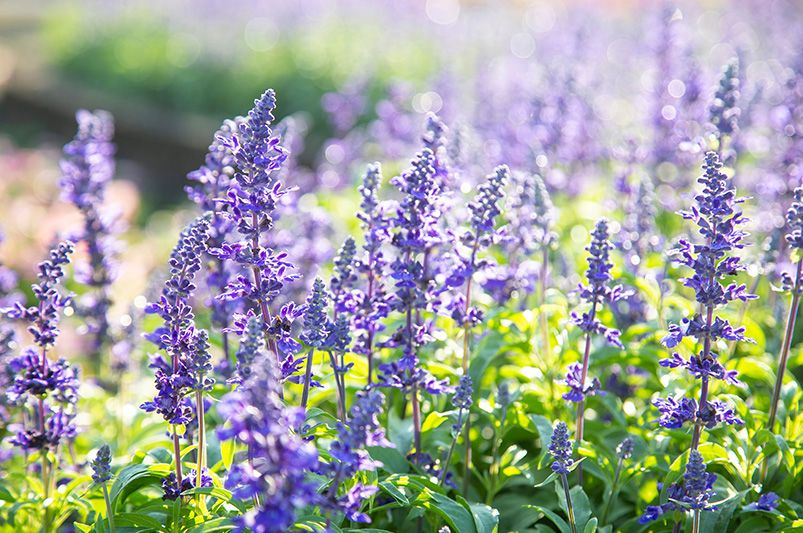
As one of the most versatile and vibrant plant groups, Salvias, or sage plants, enchant gardeners with their rich spectrum of hues, ranging from serene blues and purples to fiery reds and gentle whites. This blog post aims to guide you through the diverse palette of these wonderful perennials and annuals, showcasing how they can harmonize with any garden design. Whether you're a seasoned gardener or a budding green thumb, in this article, we will explore the captivating varieties of Salvia, their unique characteristics, and how they can orchestrate a breathtaking display in your outdoor spaces. Prepare to be inspired by the symphony of colors and forms that these plants can bring to your garden, creating a masterpiece of blooms that will resonate with beauty throughout the seasons.


Selecting the Perfect Sage and Russian Sage Varieties
Welcome to our curated collection of plant varieties that are set to elevate your garden into a realm of color, texture, and fragrance. Each carefully selected species in this list brings its unique charm, ensuring your outdoor space becomes a haven of beauty and serenity. From the soft, soothing tones of Blue Jean Baby Russian Sage to the vibrant and eye-catching Hot Lips Salvia, there's a plant here to suit every gardener's palette. Whether you're drawn to the sturdy elegance of Denim 'n Lace Russian Sage or the culinary versatility of Robert Grimm Dwarf Culinary Sage, our selection is diverse enough to cater to a wide array of tastes and garden designs. Join us as we delve into the details of these exquisite varieties, including East Friesland Salvia, Little Spire Russian Sage, May Night Salvia, Mexican Bush Sage, and the classic charm of Russian Sage itself. Get ready to be inspired by the stunning array of options available to transform your garden into a vibrant tapestry of blooms and foliage.
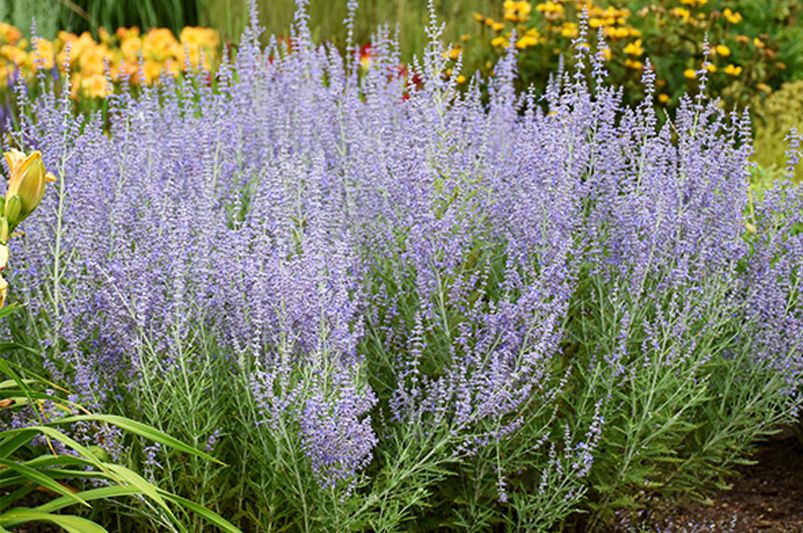
Blue Jean Baby Russian Sage
Blue Jean Baby Russian Sage is a compact perennial that thrives in full sun, making it an ideal addition to arid, sunny gardens. Plant it in well-drained soil, preferably in spring or early fall, to ensure that the roots have ample time to establish before the growing season. This variety is drought-resistant once established, and it can reach up to 2 to 3 feet in height with a similar spread, making it perfect for small spaces or as a border plant.
Plant Care
Caring for Blue Jean Baby Russian Sage is relatively low-maintenance. Regular watering during its first growing season helps to establish a deep, extensive root system. Once established, reduce the frequency, as the plant is drought-tolerant. Feed with a general-purpose fertilizer in early spring, and ensure that the soil isn't too rich, as this can promote excessive growth at the expense of flowers.
Pruning & Propagation
Prune Blue Jean Baby Russian Sage in the early spring to encourage bushier growth and prevent it from becoming leggy. Cutting back to just above the lowest set of leaves after the initial flowering can also promote a second bloom. Propagation is typically done through cuttings or division in spring, which ensures traits are carried over from parent plants.
Common Pests & Diseases
Blue Jean Baby Russian Sage is notably resistant to pests and diseases, making it a robust choice for gardeners. However, it's prudent to watch for common sage pests like whiteflies and spider mites. Keeping the area around the plants clean and well-maintained will help minimize the potential for infestation.
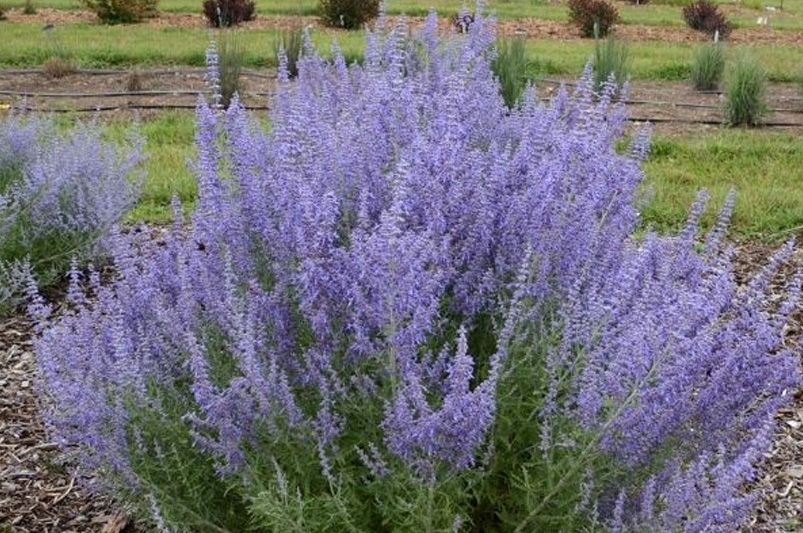
Denim 'n Lace Russian Sage
Denim 'n Lace Russian Sage, with its striking sky-blue flowers and lacy foliage, invites a touch of sophistication to any landscape. This hardy perennial prefers a sunny spot with well-draining soil. Ideal planting time is in the spring or early fall, allowing the plant to establish before extremes of heat or cold. It's known for its robust growth habit, reaching heights of up to 2 to 3 feet, and its ability to spread gracefully, offering a beautiful display without overwhelming its garden companions.
Plant Care
Once established, Denim 'n Lace Russian Sage demands little care, thriving on neglect. It’s drought-tolerant, only requiring water during prolonged dry spells. Its preference for low-fertility soil means little to no fertilization is necessary. The plant's resilience against harsh conditions makes it an excellent choice for gardeners looking to reduce their water usage without sacrificing their garden’s aesthetics.
Pruning & Propagation
Pruning should occur in early spring. Cutting the plant back by about one-third can invigorate growth and encourage denser, more vibrant flowering. Denim 'n Lace can be propagated by division in spring or by taking semi-ripe cuttings in late summer, offering an easy way to multiply this stunning plant in your garden.
Common Pests & Diseases
Denim 'n Lace Russian Sage is noted for its exceptional resistance to pests and diseases, contributing to its low-maintenance nature. Occasionally, it may be susceptible to root rot if grown in conditions that are too wet. Ensuring proper soil drainage and spacing can help mitigate this risk, allowing gardeners to enjoy this beautiful variety with minimal worry.
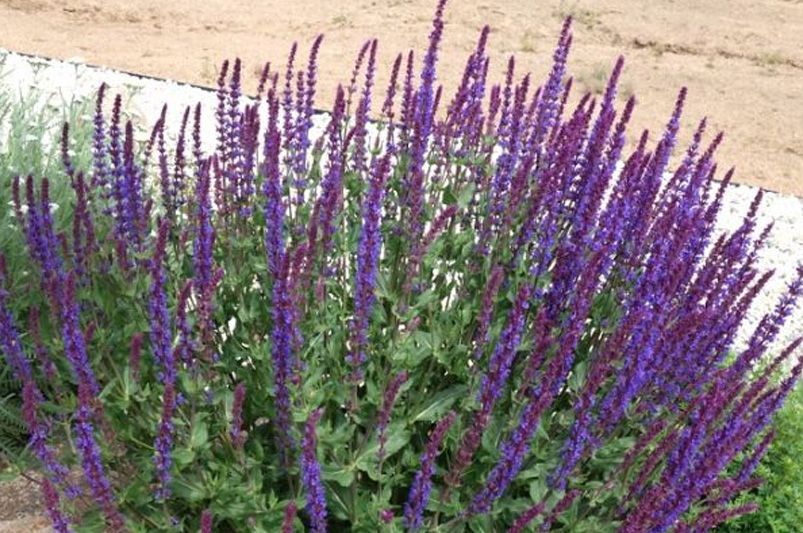
East Friesland Salvia
East Friesland Salvia, known for its vibrant deep violet spikes, is a stalwart addition to any perennial border. It flourishes best in full sun, though it can tolerate partial shade. The plant prefers well-drained, moderately fertile soil, and it benefits from a spot that showcases its colors without overshadowing smaller neighbors. Recognized for its upright growth pattern, East Friesland Salvia typically reaches about 18 to 24 inches in height, perfect for adding structure and contrast to the middle of a flower bed.
Plant Care
This salvia variety is particularly undemanding; it needs regular watering, particularly in dry conditions, but is quite drought tolerant once established. Minimal feeding is required—a light application of a general-purpose fertilizer at the start of the season suffices. It enjoys a mulch of organic material in spring to retain moisture and suppress weeds.
Pruning & Propagation
To encourage reblooming and maintain a tidy appearance, deadhead spent flower spikes throughout the growing season. Moreover, cutting the plant back after the first flush of blooms can promote a second burst of flowers. For propagation, East Friesland Salvia can be divided in the spring or fall. This not only helps to invigorate older clumps but also increases your stock of this beautiful plant.
Common Pests & Diseases
East Friesland is generally robust but keep an eye out for slugs and snails, especially in the spring. It's also worth being vigilant about powdery mildew, particularly in humid conditions. Providing good air circulation around plants and avoiding overhead watering can help prevent disease, ensuring your salvias remain healthy and vibrant.
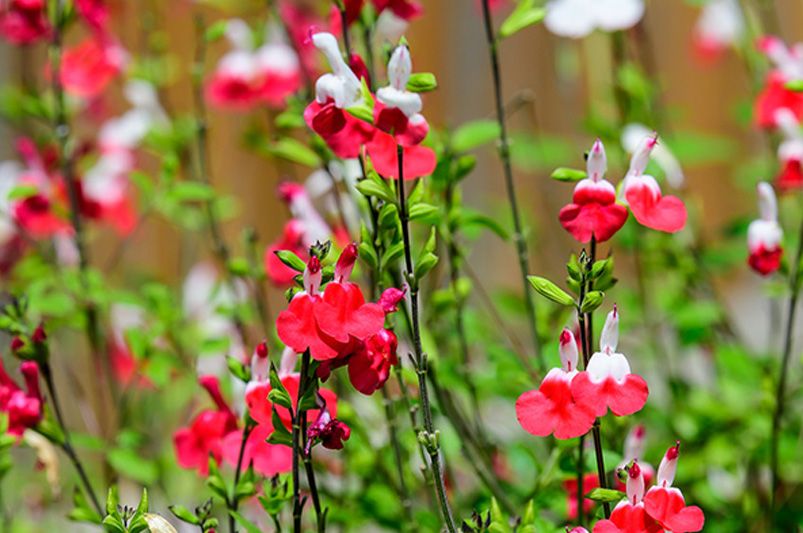
Hot Lips Salvia
Hot Lips Salvia, with its distinctive red and white bicolored flowers, is a mesmerizing plant that brings a splash of color and personality to any garden setting. Thriving in full sun to partial shade, it prefers well-drained soil and a location where it can bask in the sunlight for at least 6-8 hours daily. This robust variety can reach up to 3 feet in height and spread, contributing to its eye-catching presence. Its growth habit makes it ideal for borders, containers, and as a striking focal point in mixed beds.
Plant Care
Hot Lips Salvia is remarkably drought-tolerant, requiring minimal watering once established, making it a great choice for water-wise gardens. It responds well to a light application of a balanced, slow-release fertilizer in early spring. The soil should be kept moderately fertile to prevent overly lush foliage at the expense of blooms.
Pruning & Propagation
Pruning is essential for maintaining its vibrant display; trimming back by one-third in midsummer can rejuvenate the plant and encourage a flush of fresh flowers. Hot Lips Salvia can be propagated by taking stem cuttings in late summer or by division in spring, offering gardeners an easy way to expand their collection or share with friends.
Common Pests & Diseases
Generally resilient, Hot Lips Salvia may occasionally encounter issues with aphids and whiteflies. These can usually be managed with neem oil or insecticidal soap. Its biggest threat is root rot, which can be avoided by ensuring good drainage and not overwatering. By keeping an eye out for these concerns, gardeners can enjoy the lively blooms of Hot Lips Salvia from spring through fall.
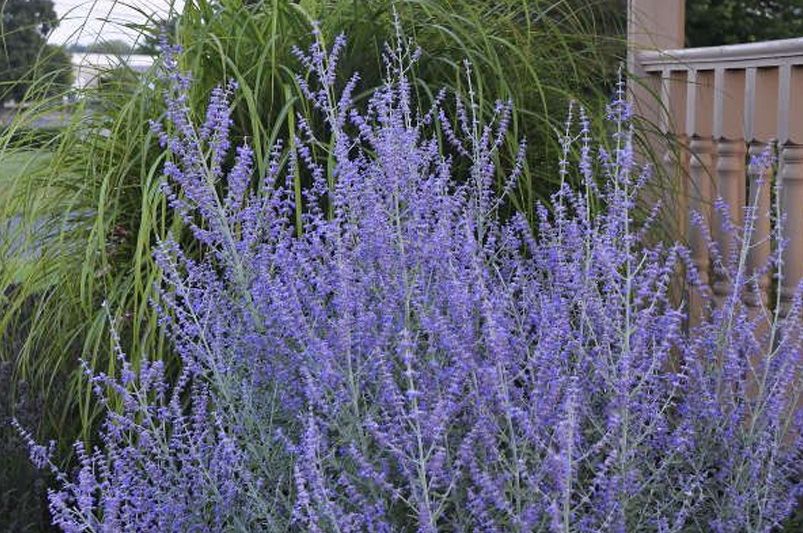
Little Spire Russian Sage
The 'Little Spire' Russian Sage is a compact variety that offers the same silvery foliage and lavender-blue blooms as its larger counterparts but in a more manageable size. Ideal for small spaces and borders, it prefers full sun and well-drained soil, conditions that mimic its native habitat. Growing to about 24 inches tall and wide, 'Little Spire' is a dwarf cultivar that provides a long season of interest without dominating the garden bed.
Plant Care
'Little Spire' is a low-maintenance plant, making it a favorite among gardeners. It withstands drought conditions and thrives in areas with hot, dry summers. Watering should be done sparingly—only when the soil is completely dry. Overwatering can lead to problems, as this plant does not like "wet feet." Fertilization is generally unnecessary, as 'Little Spire' performs well in poor to average soils, with its grayish leaves indicating a preference for low-fertility conditions.
Pruning & Propagation
Pruning should be done in late winter or early spring to remove any dead wood and shape the plant. 'Little Spire' can be propagated by dividing the root ball in early spring, allowing gardeners to spread its beauty throughout the garden or share it with others. Taking softwood cuttings in early summer is another propagation method.
Common Pests & Diseases
Remarkably resistant to pests and diseases, 'Little Spire' Russian Sage rarely encounters serious problems. On occasion, plants in too-shady or excessively damp conditions might suffer from mildew. To prevent this, ensure adequate sun exposure and good air circulation around the plants. Keeping these conditions in check will help maintain the health and vitality of 'Little Spire' Russian Sage all season long.
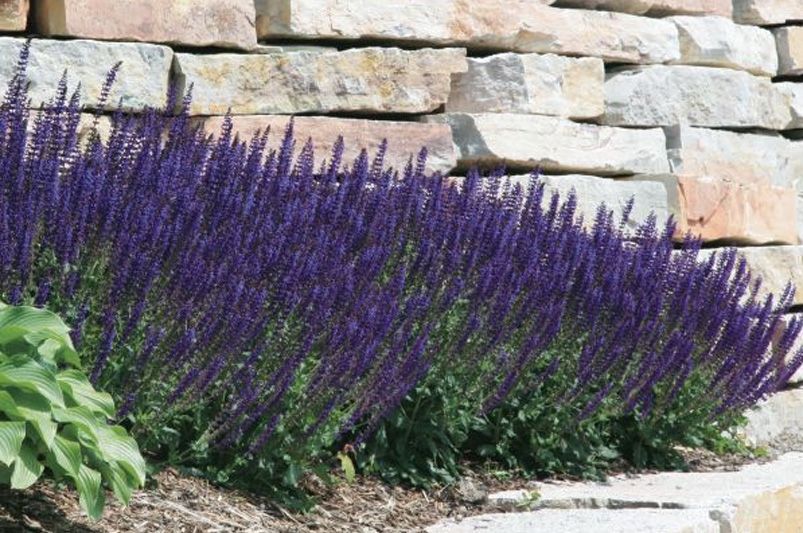
May Night Salvia
'May Night' Salvia, famed for its indigo-blue flowers and robust growth, is a prize-winning perennial that brings drama and color to any garden. Preferring full sun, this salvia cultivar grows best in well-drained soil and can adapt to a variety of soil types, including clay. Typically reaching up to 18 to 24 inches in height, 'May Night' forms a clump of aromatic foliage that is both decorative and practical, providing a vivid backdrop for other perennials.
Plant Care
Despite its luxurious appearance, 'May Night' is remarkably low maintenance and drought-resistant once established. It benefits from regular watering during extended dry periods and a light application of general-purpose fertilizer in early spring to kickstart the blooming process. Mulching around the base helps retain soil moisture and keeps weeds at bay, creating a clean and healthy growing environment.
Pruning & Propagation
For ongoing blooms and a neat appearance, deadheading spent flowers is recommended. Additionally, cutting the plant back by about one-third after the initial flowering will encourage a second bloom period in late summer. Propagation of 'May Night' Salvia can be done through division in early spring, which helps rejuvenate older plants and provides new starts to expand your garden or share with fellow gardeners.
Common Pests & Diseases
'May Night' Salvia is generally resistant to pests and diseases. However, in crowded gardens or humid climates, it can sometimes succumb to powdery mildew or be targeted by slugs. Ensuring good air circulation and maintaining clean surroundings are effective ways to prevent these issues. By observing these simple care tips, 'May Night' will thrive and reinvigorate your garden year after year.
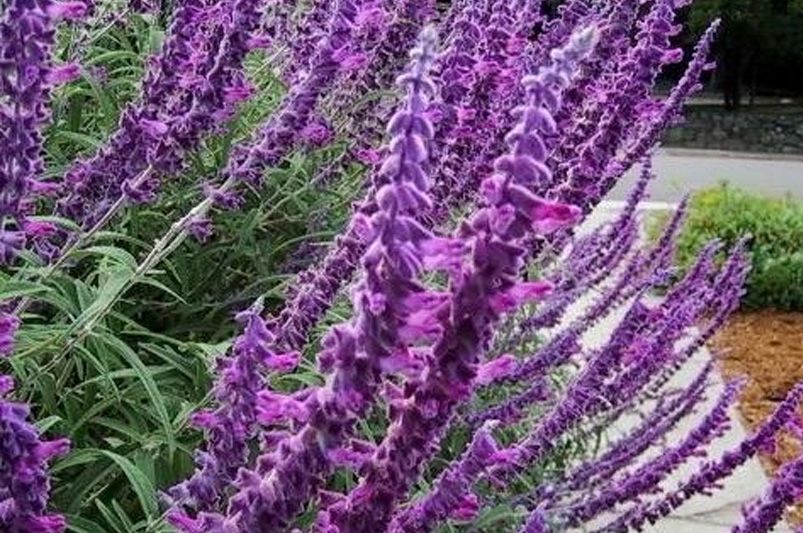
Mexican Bush Sage
Mexican Bush Sage (Salvia leucantha) is renowned for its lush, velvety purple flowers and striking silvery-green foliage. As a fast-growing perennial suited to USDA zones 7 through 10, it prefers full sun exposure to flourish and achieves optimal growth in well-drained soil. Capable of reaching heights and spreads of up to 3 to 4 feet, this plant ensures robust displays and adds a tropical flair even in temperate climates.
Plant Care
Ideal for low-water gardens, Mexican Bush Sage requires moderate watering, especially in extremely dry conditions, to maintain its vibrant blooms and hardiness. It benefits from a light application of a balanced fertilizer in early spring to support its vigorous growth and flowering capabilities. The plant is not particular about soil pH but thrives in a slightly acidic to neutral range.
Pruning & Propagation
Pruning is essential for maintaining the health and aesthetics of Mexican Bush Sage. Cutting back the plant by about one-third in late winter or early spring encourages denser growth and more prolific blooming. Additionally, occasional deadheading helps prolong the blooming period. Propagation can be effectively performed by taking semi-ripe cuttings in late summer, or by division in spring, offering gardeners a way to multiply their stock and fill out their landscapes.
Common Pests & Diseases
Mexican Bush Sage is relatively resistant to pests and diseases. Occasionally, it may encounter aphids or whiteflies, which can be controlled using insecticidal soaps or neem oil treatments. Adequate spacing and proper air circulation help prevent fungal infections such as powdery mildew. By monitoring these few potential challenges, gardeners can enjoy the spectacular and enduring beauty of Mexican Bush Sage.
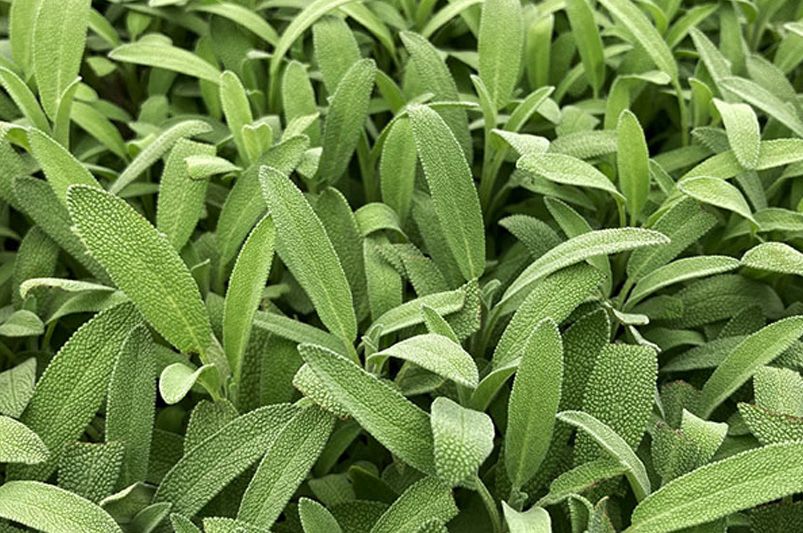
Robert Grimm Dwarf Culinary Sage
The Robert Grimm Dwarf Culinary Sage is a compact herb perfect for kitchen gardens and pots. Its smaller stature, typically growing 12 to 18 inches tall, does not diminish its capacity to produce an abundance of aromatic leaves prized for cooking. Plant this sage in a sunny spot with well-draining soil in early spring or fall for best results. Given its size, it fits nicely into mixed borders or as a fragrant edging plant.
Plant Care
Robert Grimm Sage thrives with minimal fuss. Water it regularly but let the soil dry out between watering to avoid soggy conditions that can lead to root rot. This sage variety is drought-tolerant once established and will benefit from an occasional feed with a balanced, slow-release fertilizer. Ensuring good air circulation is essential; therefore, refrain from overcrowding in the garden.
Pruning & Propagation
To keep your sage healthy and bushy, light pruning in spring is recommended. Cut back woody stems to encourage new growth. This practice can also be done post-flowering to maintain the plant's shape and promote leaf production. Propagation can be achieved by dividing the plant in early spring or by taking softwood cuttings during the growing season, allowing you to share this delightful herb with fellow gardeners.
Common Pests & Diseases
While generally robust, Robert Grimm Sage can occasionally suffer from fungal diseases like powdery mildew if the conditions are too damp or if there's insufficient airflow. Keep an eye out for common garden pests like aphids and spider mites, especially during hot, dry periods. Predatory insects or insecticidal soap can manage infestations. With proper care and vigilance, this delightful dwarf sage will be a flavorful and aromatic asset to your culinary collection.
Enchanting Elegance: Discover the Perfect Sage and Russian Sage Varieties for Your Garden Oasis
Incorporating sage and Russian Sage varieties into your garden offers a delightful exploration of visual and sensory pleasures. Whether your goal is to craft a culinary sanctuary with aromatic herbs like Robert Grimm Dwarf Culinary Sage or to create a striking visual display with the stately Blue Jean Baby and Denim 'n Lace Russian Sages, the possibilities are as extensive as they are enchanting. Our handpicked selection, ranging from the bold Hot Lips Salvia to the understated Little Spire Russian Sage, provides robust options regardless of your gardening space or style. With East Friesland Salvia and May Night Salvia gracing your borders, and the irrepressibly beautiful Mexican Bush Sage and traditional Russian Sage punctuating your landscape, you'll achieve a garden that not only thrives with life but also enhances your outdoor experience. Embrace these diverse varieties for their low-maintenance charm and the transformative effect they will have on your garden's aesthetic and ambiance. Don't wait any longer! Visit ShrubHub today and take the first step towards creating your personal Eden. Our experts are just a click away, ready to help you select the ideal plants to bring your garden dreams to life. With our premium quality and diverse range, your outdoor sanctuary will bloom with the beauty and tranquility of nature.


